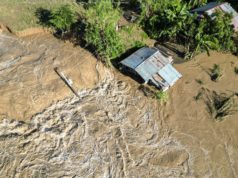In the first two parts of this report, I have estimated that about 2.4 million people have been killed as a result of the…
In the first two parts of this report, I have estimated that about 2.4 million people have been killed as a result of the U. S. invasion of Iraq, while about 1.2 million have been killed in Afghanistan and Pakistan as a result of the U. S.-led war in Afghanistan. In the third and final part of this report, I will estimate how many people have been killed as a result of U. S. military and CIA interventions in Libya, Syria, Somalia and Yemen.
Of the countries that the U. S. has attacked and destabilized since 2001, only Iraq has been the subject of comprehensive “active” mortality studies that can reveal otherwise unreported deaths. An “active” mortality study is one that “actively” surveys households to find deaths that have not previously been reported by news reports or other published sources.
These studies are often carried out by people who work in the field of public health, like Les Roberts at Columbia University, Gilbert Burnham at Johns Hopkins and Riyadh Lafta at Mustansiriya University in Baghdad, who co-authored the 2006 Lancet study of Iraq war mortality. In defending their studies in Iraq and their results, they emphasized that their Iraqi survey teams were independent of the occupation government and that was an important factor in the objectivity of their studies and the willingness of people in Iraq to talk honestly with them.
Comprehensive mortality studies in other war-torn countries (like Angola, Bosnia, the Democratic Republic of Congo, Guatemala, Iraq, Kosovo, Rwanda, Sudan and Uganda) have revealed total numbers of deaths that are 5 to 20 times those previously revealed by “passive” reporting based on news reports, hospital records and/or human rights investigations.
In the absence of such comprehensive studies in Afghanistan, Pakistan, Libya, Syria, Somalia and Yemen, I have evaluated passive reports of war deaths and tried to assess what proportion of actual deaths these passive reports are likely to have counted by the methods they have used, based on ratios of actual deaths to passively reported deaths found in other war-zones.
I have only estimated violent deaths. None of my estimates include deaths from the indirect effects of these wars, such as the destruction of hospitals and health systems, the spread of otherwise preventable diseases and the effects of malnutrition and environmental pollution, which have also been substantial in all these countries.
For Iraq, my final estimate of about 2.4 million people killed was based on accepting the estimates of the 2006 Lancet study and the 2007 Opinion Research Business (ORB) survey, which were consistent with each other, and then applying the same ratio of actual deaths to passively reported deaths (11.5:1) as between the Lancet study and Iraq Body Count (IBC) in 2006 to IBC’s count for the years since 2007.
U. S. Army forces operating in southern Iraq during Operation Iraqi Freedom, Apr. 2,2003 (U. S. Navy photo)
For Afghanistan, I estimated that about 875,000 Afghans have been killed. I explained that the annual reports on civilian casualties by the UN Assistance Mission to Afghanistan (UNAMA) are based only on investigations completed by the Afghanistan Independent Human Rights Commission (AIHRC), and that they knowingly exclude large numbers of reports of civilian deaths that the AIHRC has not yet investigated or for which it has not completed its investigations. UNAMA’s reports also lack any reporting at all from many areas of the country where the Taliban and other Afghan resistance forces are active, and where many or most U. S. air strikes and night raids therefore take place.
I concluded that UNAMA’s reporting of civilian deaths in Afghanistan appears to be as inadequate as the extreme under-reporting found at the end of the Guatemalan Civil War, when the UN-sponsored Historical Verification Commission revealed 20 times more deaths than previously reported.
For Pakistan, I estimated that about 325,000 people had been killed. That was based on published estimates of combatant deaths, and on applying an average of the ratios found in previous wars (12.5:1) to the number of civilian deaths reported by the South Asia Terrorism Portal (SATP) in India.
In the third and final part of this report, I will estimate the death toll caused by U. S. covert and proxy wars in Libya, Syria, Somalia and Yemen.
Senior U. S. military officers have hailed the U. S. doctrine of covert and proxy war that found its full flowering under the Obama administration as a “disguised, quiet, media-free” approach to war, and have traced the development of this doctrine back to U. S. wars in Central America in the 1980s. While the U. S. recruitment, training, command and control of death squads in Iraq was dubbed “the Salvador Option,” U. S. strategy in Libya, Syria, Somalia and Yemen has in fact followed this model even more closely.
These wars have been catastrophic for the people of all these countries, but the U. S.’s “disguised, quiet, media-free” approach to them has been so successful in propaganda terms that most Americans know very little about the U. S. role in the intractable violence and chaos that has engulfed them.
The very public nature of the illegal but largely symbolic missile strikes on Syria on April 14,2018 stands in sharp contrast to the “disguised, quiet, media-free” U. S.-led bombing campaign that has destroyed Raqqa, Mosul and several other Syrian and Iraqi cities with more than 100,000 bombs and missiles since 2014.
“Did they take place? And are they in all cases attributable to U. S. foreign policy? The answer is yes, they did take place, and they are in all cases attributable to American foreign policy. But you wouldn’t know it. It never happened. Nothing ever happened. Even while it was happening, it wasn’t happening. It didn’t matter. It was of no interest.”
For more detailed background on the critical role the U. S. has played in each of these wars, please read my article, “Giving War Too Many Chances,” published in January 2018.
The only legal justification for NATO and its Arab monarchist allies to have dropped at least 7,700 bombs and missiles on Libya and invaded it with special operations forces beginning in February 2011 was UN Security Council resolution 1973, which authorized “all necessary measures” for the narrowly defined purpose of protecting civilians in Libya.
But the war instead killed far more civilians than any estimate of the number killed in the initial rebellion in February and March 2011, which ranged from 1,000 (a UN estimate) to 6,000 (according to the Libyan Human Rights League). So the war clearly failed in its stated, authorized purpose, to protect civilians, even as it succeeded in a different and unauthorized one: the illegal overthrow of the Libyan government.
SC resolution 1973 expressly prohibited “a foreign occupation force of any form on any part of Libyan territory.” But NATO and its allies launched a covert invasion of Libya by thousands of Qatari and Western special operations forces, who planned the rebels’ advance across the country, called in air strikes against government forces and led the final assault on the Bab al-Aziziya military headquarters in Tripoli.
“We were among them and the numbers of Qataris on the ground were in the hundreds in every region. Training and communications had been in Qatari hands. Qatar… supervised the rebels’ plans because they are civilians and did not have enough military experience. We acted as the link between the rebels and NATO forces.”
Smoke is seen after an NATO airstrikes hit Tripoli, Libya Photo: REX
A parliamentary Foreign Affairs Committee inquiry in the U. K. in 2016 concluded that a “limited intervention to protect civilians drifted into an opportunistic policy of regime change by military means,” resulting in, “political and economic collapse, inter-militia and inter-tribal warfare, humanitarian and migrant crises, widespread human rights violations, the spread of Gaddafi regime weapons across the region and the growth of Isil [Islamic State] in north Africa.”
Once the Libyan government was overthrown, journalists tried to inquire about the sensitive subject of civilian deaths, which was so critical to the legal and political justifications for the war. But the National Transitional Council (NTC), the unstable new government formed by Western-backed exiles and rebels, stopped issuing public casualty estimates and ordered hospital staff not to release information to reporters.
In any case, as in Iraq and Afghanistan, morgues were overflowing during the war and many people buried their loved ones in their backyards or wherever they could, without taking them to hospitals.
Barakat’s statement did not include separate counts of combatant and civilian deaths. But he said that about half of the 30,000 reported dead were troops loyal to the government, including 9,000 members of the Khamis Brigade, led by Gaddafi’s son Khamis. Barakat asked the public to report deaths in their families and details of missing persons when they came to mosques for prayers that Friday. The NTC’s estimate of 30,000 people killed appeared to consist mainly of combatants on both sides.
The most comprehensive survey of war deaths since the end of the 2011 war in Libya was an “epidemiological community-based study” titled “Libyan Armed Conflict 2011: Mortality, Injury and Population Displacement.” It was authored by three medical professors from Tripoli, and published in the African Journal of Emergency Medicine in 2015.
The authors took records of war deaths, injuries and displacement collected by the Ministry of Housing and Planning, and sent teams to conduct face-to-face interviews with a member of each family to verify how many members of their household were killed, wounded or displaced. They did not try to separate the killing of civilians from the deaths of combatants.
Nor did they try to statistically estimate previously unreported deaths through the “cluster sample survey” method of the Lancet study in Iraq. But the Libyan Armed Conflict study is the most complete record of confirmed deaths in the war in Libya up to February 2012, and it confirmed the deaths of at least 21,490 people.
In 2014, the ongoing chaos and factional fighting in Libya flared up into what Wikipedia now calls a second Libyan Civil War. A group called Libya Body Count (LBC) began tabulating violent deaths in Libya, based on media reports, on the model of Iraq Body Count (IBC). But LBC only did so for three years, from January 2014 until December 2016. It counted 2,825 deaths in 2014,1,523 in 2015 and 1,523 in 2016. (The LBC website says it was just a coincidence that the number was identical in 2015 and 2016.)
The U. K.-based Armed Conflict Location and Event Data (ACLED) project has also kept a count of violent deaths in Libya. ACLED counted 4,062 deaths in 2014-6, compared with 5,871 counted by Libya Body Count. For the remaining periods between March 2012 and March 2018 that LBC did not cover, ACLED has counted 1,874 deaths.
If LBC had covered the whole period since March 2012, and found the same proportionally higher number than ACLED as it did for 2014-6, it would have counted 8,580 people killed.
Combining the figures from the Libyan Armed Conflict 2011 study and our combined, projected figure from Libya Body Coun t and ACLED gives a total of 30,070 passively reported deaths since February 2011.
The Libyan Armed Conflict (LAC) study was based on official records in a country that had not had a stable, unified government for about 4 years, while Libya Body Count was a fledgling effort to emulate Iraq Body Count that tried to cast a wider net by not relying only on English-language news sources.
In Iraq, the ratio between the 2006 Lancet study and Iraq Body Count was higher because IBC was only counting civilians, while the Lancet study counted Iraqi combatants as well as civilians. Unlike Iraq Body Count, both our main passive sources in Libya counted both civilians and combatants. Based on the one-line descriptions of each incident in the Libya Body Count database, LBC’s total appears to include roughly half combatants and half civilians.
Military casualties are generally counted more accurately than civilian ones, and military forces have an interest in accurately assessing enemy casualties as well as identifying their own. The opposite is true of civilian casualties, which are nearly always evidence of war crimes that the forces who killed them have a strong interest in suppressing.
So, in Afghanistan and Pakistan, I treated combatants and civilians separately, applying typical ratios between passive reporting and mortality studies only to civilians, while accepting reported combatant deaths as they were passively reported.
But the forces fighting in Libya are not a national army with the strict chain of command and organizational structure that results in accurate reporting of military casualties in other countries and conflicts, so both civilian and combatant deaths appear to be significantly under-reported by my two main sources, the Libya Armed Conflict study and Libya Body Count. In fact, the National Transitional Council’s (NTC) estimates from August and September 2011 of 30,000 deaths were already much higher than the numbers of war deaths in the LAC study.
When the 2006 Lancet study of mortality in Iraq was published, it revealed 14 times the number of deaths counted in Iraq Body Count’s list of civilian deaths. But IBC later discovered more deaths from that period, reducing the ratio between the Lancet study’s estimate and IBC’s revised count to 11.5:1.
The combined totals from the Libya Armed Conflict 2011 study and Libya Body Count appear to be a larger proportion of total violent deaths than Iraq Body Count has counted in Iraq, mainly because LAC and LBC both counted combatants as well as civilians, and because Libya Body Count included deaths reported in Arabic news sources, while IBC relies almost entirely on English language news sources and generally requires “a minimum of two independent data sources” before recording each death.






